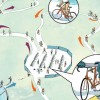Runner’s World
FOR THE TRIATHLON, prerace prep requires more than knotting your laces and visiting the porta-potty. Try to arrive at least 90 minutes before the start so you have time to pick up your packet (if you can get it on race day), set up your transition area, and get your number marked on your body. Make sure you know where you’ll come into the transition area from the swim, as well as where you’ll leave it on the bike and in the run.
Once you’ve got your gear and yourself ready, warm up in reverse order: Do a little run, take your bike out for a spin, then get your wetsuit on and get in the water for a few strokes. That way, you can be sure all your equipment is set. If you’re nervous at the start, move to the side and count to five after the gun goes off; that way you’ll have some space from the chaos.
1. THE SWIM
You’ll likely be starting in a wave with athletes in your age group (the waves go off every few minutes). Just focus on keeping an even stroke and a controlled pace.
Every five strokes or so, lift your eyes—not your whole head—out of the water to see if you’re going in the right direction. If that’s too challenging, switch to breaststroke to check your course; just keep going—regaining momentum after treading water is energysucking and tough.
If you can, draft behind somebody going at a similar pace to save energy. Don’t lift your head repeatedly to keep an eye on your drafter, just look for and follow the bubbles.
As you get out of the water, reach back, unzip your wetsuit, and pull it down to your waist. You’ll take it all off in your transition area.
Transition One:
As soon as you’re in your transition area, take off the rest of your wetsuit, your goggles, and your cap. Dry your feet before putting on your cycling shoes, then buckle your helmet and get your bike. Now is the time to think about grabbing something to eat and drink. Got everything? Run the bike to the cycling route, where you can mount it.
2. THE BIKE
Even though you’re feeling strong (and psyched the swim is over), don’t go too hard and fry your legs for the run. “Even accomplished runners can end up run/walking the last leg because they didn’t gauge their effort right,” says triathlon coach Lesley Mettler. On the bike, aim for 7 on an effort scale of 10. This is also the best time to refuel since it’s easiest to eat and drink on the bike.
If your legs tighten up, stand up on the pedals to stretch out your calves and hamstrings.
Stay to the right, unless you’re passing, which is done on the left. Say, “On your left,” to alert somebody of your presence.
Drafting isn’t allowed in most races, and you should stay three bike lengths behind a cyclist in front of you.
Transition Two:
After the bike leg, dismount, and run your bike to your transition area. Rack it, take off your helmet, change shoes, and head out, aiming for a steady rhythm and pace.
3. THE RUN
Focus on your cadence and arm swing during the first mile. At this point in the race, your legs will be crying uncle, but your freshly rested arms can help pick up the slack. “Your legs fall in line with your arms, so I think about my swing when I get tired,” says Olympic triathlete Sarah Haskins. “At this point in the race, a 10-K should feel more like a half-marathon effort.”

